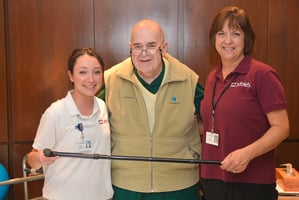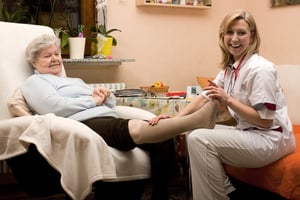Tom is a former CPA turned business executive at the paint company, Glidden. This past year has...
Introduction to Lymphedema
Lymphedema refers to swelling in the body due to a blockage of the lymph passages. It is a chronic disease that typically requires lifelong management. Caring for lymphedema generally requires the assistance and skill of a highly trained nurse. Learn more about this condition.
What is Lymphedema?
As defined by the National Lymphedema Network, it is an accumulation of lymphatic fluid in the interstitial tissue that causes swelling, most often in the arm(s) and/or leg(s), and occasionally in other parts of the body.
In some cases, lymphedema can improve with time. However the swelling can be permanent. It can also cause seeping and open wounds when there is too much fluid.
There are two types of lymphedema: primary and secondary.
Primary lymphedema, which can be present at birth, results from problems in the development of the lymphatic vessels.
Secondary lymphedema occurs when the lymph vessels are damaged, or the lymph nodes are removed. It can appear years after a treatment or surgery such as mastectomy, knee replacement and much more.
“Our bodies change and Lymphedema can occur at anytime,” says Pamela Bebenroth, VNA Physical Therapist and Certified Lymphedema Therapist. “The key is proper treatment for your needs today, and the education for proper management in the long-run.”
Lymphedema Care For the Home Healthcare Patient
Lymphedema care for the homebound is generally considered a skilled practice. You must work closely with your provider to understand your situation, what and what not might be covered by your insurance, and your long-term management plans for the condition.
Every patient has unique needs when it comes to lymphedema. Specialized treatment plans are delivered by an interdisciplinary team of medical professionals, including: doctors, physical therapists, occupational therapists, nurses, certified wound nurses, and certified lymphedema therapists.
General Tips for Lymphedema Patients
According to Bebenroth, there are several universal tips for patients, but all must follow the plans and advice of their doctors and therapists:
- Elevate extremities.
- Conduct exercises as prescribed.
- Keep area or wounds clean through proper washing.
- Apply lotion and other prescribed skin recommendations.
- Use compression, bandage and garment etiquette and proper hygiene.
- Stay vigilant to change: Contact your doctor or call 911 when skin areas are hot, red, or painful, accompanied by fever.
“The best feeling is when we see a patient able to wear their own shoes again, or other similar achievements,” added Bebenroth. “One patient joked that they were afraid to step on their leg again because it had become much thinner with treatment. We see success stories like this all of the time and it encourages our patients to stay dedicated to their plan.”
Call VNA of Ohio Today
Learn more about Visiting Nurse Association of Ohio's lymphedema therapy services, or call us today at 1-877-698-6264.



